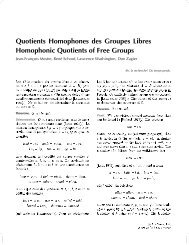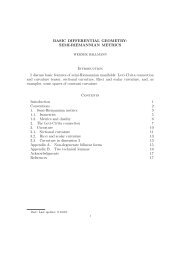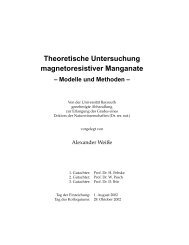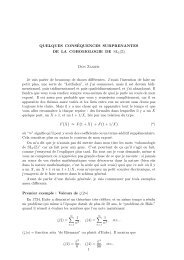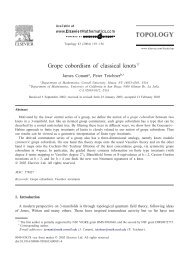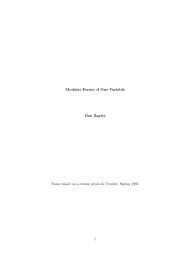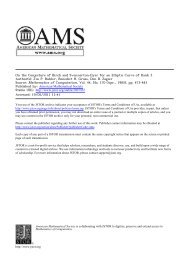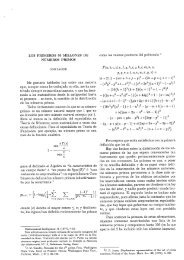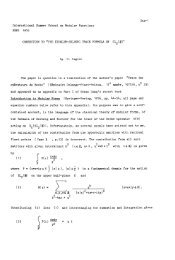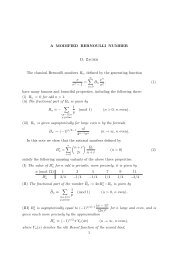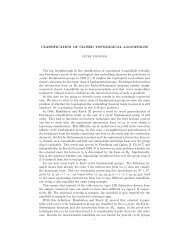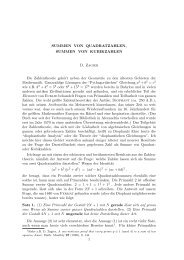14 D. Zagierfor the Eisenstein series (the factor 1 2arises because (c d) <strong>and</strong> (−c − d) givethe same element of Γ 1 \Γ 1 ). It is easy to see that this sum is absolutelyconvergent for k>2 (the number of pairs (c, d) with N ≤|cz + d| 2, z∈ H) , (10)where the sum is again absolutely <strong>and</strong> locally uniformly convergent for k>2,guaranteeing that G k ∈ M k (Γ 1 ). The modularity can also be seen directly bynoting that (G k | k γ)(z) = ∑ m,n (m′ z + n ′ ) −k where (m ′ ,n ′ )=(m, n)γ runsover the non-zero vectors of Z 2 {(0, 0)} as (m, n) does.In fact, the two functions (9) <strong>and</strong> (10) are proportional, as is easily seen:any non-zero vector (m, n) ∈ Z 2 can be written uniquely as r(c, d) with r (thegreatest common divisor of m <strong>and</strong> n) a positive integer <strong>and</strong> c <strong>and</strong> d coprimeintegers, soG k (z) = ζ(k) E k (z) , (11)where ζ(k) = ∑ r≥1 1/rk is the value at k of the Riemann zeta function. Itmay therefore seem pointless to have introduced both definitions. But in fact,this is not the case. First of all, each definition gives a distinct point of view<strong>and</strong> has advantages in certain settings which are encountered at later pointsin the theory: the E k definition is better in contexts like the famous Rankin-Selberg method where one integrates the product of the Eisenstein series withanother modular form over a fundamental domain, while the G k definition isbetter for analytic calculations <strong>and</strong> for the Fourier development given in §2.2.
<strong>Elliptic</strong> <strong>Modular</strong> <strong>Forms</strong> <strong>and</strong> <strong>Their</strong> <strong>Applications</strong> 15Moreover, if one passes to other groups, then there are σ Eisenstein series ofeach type, where σ is the number of cusps, <strong>and</strong>, although they span the samevector space, they are not individually proportional. In fact, we will actuallywant to introduce a third normalizationG k (z) =(k − 1)!(2πi) k G k(z) (12)because, as we will see below, it has Fourier coefficients which are rationalnumbers (<strong>and</strong> even, with one exception, integers) <strong>and</strong> because it is a normalizedeigenfunction for the Hecke operators discussed in §4.As a first application, we can now determine the ring structure of M ∗ (Γ 1 )Proposition 4. The ring M ∗ (Γ 1 ) is freely generated by the modular forms E 4<strong>and</strong> E 6 .Corollary. The inequality (7) for the dimension of M k (Γ 1 ) is an equality forall even k ≥ 0.Proof. The essential point is to show that the modular forms E 4 (z) <strong>and</strong>E 6 (z) are algebraically independent. <strong>To</strong> see this, we first note that the formsE 4 (z) 3 <strong>and</strong> E 6 (z) 2 of weight 12 cannot be proportional. Indeed, if we hadE 6 (z) 2 = λE 4 (z) 3 for some (necessarily non-zero) constant λ, then themeromorphic modular form f(z) =E 6 (z)/E 4 (z) of weight 2 would satisfyf 2 = λE 4 (<strong>and</strong> also f 3 = λ −1 E 6 ) <strong>and</strong> would hence be holomorphic (a functionwhose square is holomorphic cannot have poles), contradicting the inequalitydim M 2 (Γ 1 ) ≤ 0 of Corollary 1 of Proposition 2. But any two modularforms f 1 <strong>and</strong> f 2 of the same weight which are not proportional are necessarilyalgebraically independent. Indeed, if P (X, Y ) is any polynomial in C[X, Y ]such that P (f 1 (z),f 2 (z)) ≡ 0, then by considering the weights we see thatP d (f 1 ,f 2 ) has to vanish identically for each homogeneous component P d of P .But P d (f 1 ,f 2 )/f2d = p(f 1/f 2 ) for some polynomial p(t) in one variable, <strong>and</strong>since p has only finitely many roots we can only have P d (f 1 ,f 2 ) ≡ 0 if f 1 /f 2is a constant. It follows that E4 3 <strong>and</strong> E2 6 , <strong>and</strong> hence also E 4 <strong>and</strong> E 6 , are algebraicallyindependent. But then an easy calculation shows that the dimensionof the weight k part of the subring of M ∗ (Γ 1 ) which they generate equals theright-h<strong>and</strong> side of the inequality (7), so that the proposition <strong>and</strong> corollaryfollow from this inequality.2.2 Fourier Expansions of Eisenstein SeriesRecall from (3) that any modular form on Γ 1 has a Fourier expansion of theform ∑ ∞n=0 a nq n ,whereq = e 2πiz . The coefficients a n often contain interestingarithmetic information, <strong>and</strong> it is this that makes modular forms importantfor classical number theory. For the Eisenstein series, normalized by (12), thecoefficients are given by:



